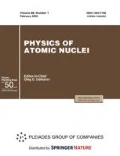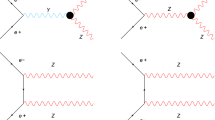Abstract
The spectroscopy of exotic states with hidden charm is discussed. Together with charmonium, these provide a good tool for testing theories of the strong interactions including both perturbative and nonperturbative QCD, lattice QCD, potential and other phenomenological models. An elaborated analysis of exotics spectrum is given, and attempts to interpret recent experimentally observed states with masses above the D\(\bar D\) threshold region are considered. Experimental results from different collaborations (BES, BaBar, Belle, LHCb) are analyzed with special attention given to recently discovered hidden charm states. Some of these states can be interpreted as higher-lying charmonium states and others as tetraquarks with hidden charm. It has been shown that charged/neutral tetraquarks must have their neutral/charge partners with mass values differing by at most a few MeV. However, measurements of different decay modes are needed before firm conclusions can be made. These data can be derived directly from the experiments using a high quality antiproton beam with momentum up to 15 GeV/c and proton–proton collisions with momentum up to 26 GeV/c.
Similar content being viewed by others
References
W. Erni et al., arXiv:0903.3905v1.
N. Brambilla et al., Eur. Phys. J. C 71, 1534 (2011).
J. Beringer et al. (Particle Data Group), Phys. Rev. D 86, 010001 (2012).
S. Godfrey and S. L. Olsen, Ann. Rev. Nucl. Part. Sci. 58, 51 (2008).
S. L. Olsen, arXiv:0909.2713v1.
M. Yu. Barabanov, A. S. Vodopyanov, and V. Kh. Dodokhov, Phys. Part. Nucl. Lett. 8, 1069 (2011).
M. Yu. Barabanov, A. S. Vodopyanov, and S. L. Olsen, Phys. Atom. Nucl. 77, 126 (2014).
M. Yu. Barabanov et al., Russ. Phys. J. 50, 1243 (2007).
M. Yu. Barabanov et al., Hadronic J. 32, 159 (2009).
L. Maiani, A. D. Polosa, and V. Riquer, Phys. Rev. Lett. 99, 182003 (2007).
R. Aaij et al. (LHCb Collab.), Phys. Rev. Lett. 110, 222001 (2013).
M. Ablikim et al. (BESIII Collab.), Phys. Rev. Lett. 110, 252001 (2013).
M. Ablikim et al. (BESIII Collab.), Phys. Rev. Lett. 112, 022001 (2014).
Z. Q. Liu et al. (Belle Collab.), Phys. Rev. Lett. 110, 252002 (2013).
M. Ablikim et al. (BESIII Collab.), Phys. Rev. Lett. 111, 242001 (2013).
M. Ablikim et al. (BESIII Collab.), Phys. Rev. Lett. 112, 132001 (2014).
R. Mizuk et al. (Belle Collab.), Phys. Rev. D 78, 072004 (2008).
S.-K. Choi et al. (Belle Collab.), Phys. Rev. Lett. 100, 142001 (2008).
K. Chilikin et al. (Belle Collab.), arXiv:1408.6457v1.
Author information
Authors and Affiliations
Corresponding author
Additional information
The text was submitted by the authors in English.
Rights and permissions
About this article
Cite this article
Barabanov, M.Y., Vodopyanov, A.S., Zinchenko, A.I. et al. Perspective study of charmonium and exotics above the D\(\bar D\) threshold. Phys. Atom. Nuclei 79, 126–129 (2016). https://doi.org/10.1134/S1063778816010063
Received:
Accepted:
Published:
Issue Date:
DOI: https://doi.org/10.1134/S1063778816010063




